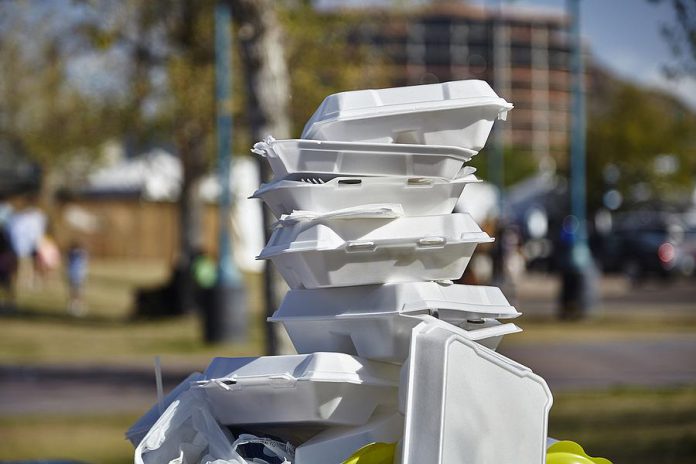
Springtime brings back the robins and it also brings many of us out of hibernation. As we organize our closets, put away the winter coats, dig out the umbrellas, and venture out to enjoy the warmth, we can also take the time to investigate the environment that we share and reflect upon choices that will make our community even more beautiful.
Walking through Jackson Park, you’ll notice the snow has disappeared and has left behind the litter it was hiding. Unfortunately, it is not hard to see the “white pollution” that has emerged from the snow; single-use Styrofoam cups and containers line the creek and hiking trails.
The City of Peterborough stopped recycling polystyrene at the beginning of 2016. Don Briand, Coordinator Waste Operations for the City of Peterborough, mentions that it will take time to notice the impact of Styrofoam entering the landfill.
“Styrofoam is light and we track incoming waste by weight,” says Briand.
Styrofoam may not be disappearing anytime soon. It is light to ship, insulating, and food safe, which is why it is so popular for food vendors — but this packaging packs an environmental punch. It is non-biodegradable and will still be here once the consumer is long gone. It takes 500 years for this product to break down in the environment and, with the landfill filling up, it’s time to look at alternatives.
Banning polystyrene products through policy has been recently sweeping through the United States. As of July 1st of this year, New York City will implement its ban on polystyrene foam, single-use packaging. Many cities on the west coast, such as Seattle, have already banned polystyrene resulting in higher diversion rates.
Could Peterborough ban polystyrene? Participation is the key. All 135,000 residents in the City and County of Peterborough would need to get on board with this type of initiative as it would mean changes in lifestyle and in commonly purchased household goods.
Decisions like these move communities closer to a circular economy, which considers the full life cycle of an item. Rather than a linear path — where a bottle is used once and ends up in a landfill — items are reused and recycled in a loop for as long as possible.
The City of Peterborough’s waste diversion rate is 55% compared to 50% in 2010. This is a great accomplishment for a community of our size, but we can do better. In its Waste Management Master Plan produced in 2012, the City of Peterborough committed to a 75% diversion rate over the next 20 years.
So what can you do to help attain this goal?
Lily Hamill, Waste Management Communication Officer for the County of Peterborough, notes that consumers can reduce polystyrene products when purchasing meat. She suggests buying meat locally, packaged in butcher paper. Unwaxed, clean paper can be recycled.
You can also reuse polystyrene in your household. Break it apart and use it in your planters this spring for drainage. Or let the kids use it as recycled building blocks.
Call first to be sure, but you can save your clean Styrofoam in a bag and bring it to some shipping stores. The UPS store at 266 Charlotte Street in Peterborough can reuse your packing peanuts.
Try bringing your own containers to restaurants. The GreenUP Store and Resource Centre in downtown Peterborough has a great selection of reusable containers for sale.
Help our city reach its diversion target by getting your kids involved. Check out recyclerangers.ca for fun and educational ideas. Have them fill out the Recycle Rangers passport as an Earth Day activity.
To find out what sustainable activities are happening in the area, check out the GreenUP events calendar at greenup.on.ca and the Sustainable Peterborough Community Plan at sustainablepeterborough.ca.
And don’t forget — the whole family can participate in the 18th Annual Earth Day Jackson Creek Clean UP on Saturday April 23, 2016 from 10 a.m. to 12 p.m.


























